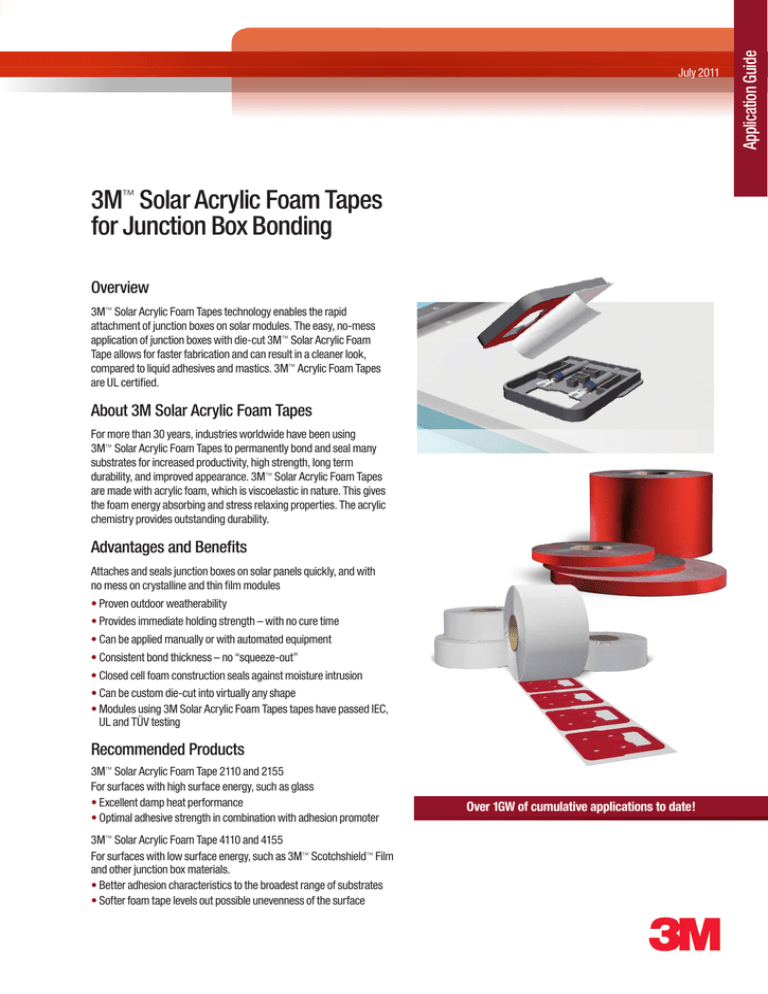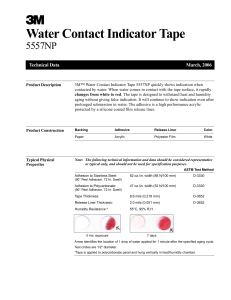
3M™ Solar Acrylic Foam Tapes
for Junction Box Bonding
Overview
3M™ Solar Acrylic Foam Tapes technology enables the rapid
attachment of junction boxes on solar modules. The easy, no-mess
application of junction boxes with die-cut 3M™ Solar Acrylic Foam
Tape allows for faster fabrication and can result in a cleaner look,
compared to liquid adhesives and mastics. 3M™ Acrylic Foam Tapes
are UL certified.
About 3M Solar Acrylic Foam Tapes
For more than 30 years, industries worldwide have been using
3M™ Solar Acrylic Foam Tapes to permanently bond and seal many
substrates for increased productivity, high strength, long term
durability, and improved appearance. 3M™ Solar Acrylic Foam Tapes
are made with acrylic foam, which is viscoelastic in nature. This gives
the foam energy absorbing and stress relaxing properties. The acrylic
chemistry provides outstanding durability.
Advantages and Benefits
Attaches and seals junction boxes on solar panels quickly, and with
no mess on crystalline and thin film modules
• Proven outdoor weatherability
• P rovides immediate holding strength – with no cure time
• Can be applied manually or with automated equipment
• Consistent bond thickness – no “squeeze-out”
• Closed cell foam construction seals against moisture intrusion
• C an be custom die-cut into virtually any shape
•M
odules using 3M Solar Acrylic Foam Tapes tapes have passed IEC,
UL and TÜV testing
Recommended Products
3M™ Solar Acrylic Foam Tape 2110 and 2155
For surfaces with high surface energy, such as glass
• E xcellent damp heat performance
• Optimal
adhesive strength in combination with adhesion promoter
3M™ Solar Acrylic Foam Tape 4110 and 4155
For surfaces with low surface energy, such as 3M™ Scotchshield™ Film
and other junction box materials.
• B etter adhesion characteristics to the broadest range of substrates
• S ofter foam tape levels out possible unevenness of the surface
Over 1GW of cumulative applications to date!
Application Guide
July 2011
3M™ Solar Acrylic Foam Tapes for Junction Box Bonding
Adhesion Testing
90° Peel Test
Tape selection considerations
The following tests measured tape adhesion on various substrates after
sitting for 20 minutes at room temperature; after 1000 hours at room
temperature; and after 1000 hours at 85°C/85% relative humidity. This
particular series was conducted using a test called the 90° Peel.
3M Solar Acrylic Foam Tapes enable intimate contact with the
substrate (“Wet-Out”). This is required to allow molecular interaction
to build to maximum adhesion.
15 psi
Pressure sensitive adhesive flows over time
Because the surface energy of the substrate will impact wet-out,
3M Solar Acrylic Foam Tapes are available in various adhesive
formulations optimized for different substrate materials. The use of the
adhesion promoters* will improve initial adhesion. Generally:
• 3 M™ Adhesion Promoter AP111 will optimize adhesive to metals,
paints and plastics.
90°
Aluminum Strip
Tape Strip
• 3 M Adhesion Promoter 4298UV allows for improved adhesion to
multiple substrates.
™
• 3 M™ Adhesion Promoter AP115 will improve moisture durability
on glass.
3M uses a number of industry-standard tests to determine tape bond
strength and durability on various substrates and under different
environmental conditions.
Static Shear Test
This test records the time required to shear a defined area of tape from
a test panel at a constant load under a number of variable conditions,
including sample size; substrate material; load; heat and humidity.
Dynamic Shear Test
The 90° peel test records the amount of force required to achieve
tape failure, by peeling a standard width of tape from a test panel on a
moving constant 90° fixture. In this test, adhesive strength is measured
in two ways: Cohesive Failure is when the foam backing fails within
itself; Adhesive Failure is when the adhesive completely de-bonds from
the substrate. For Junction Box applications it is preferable for a tape to
fail as a result of cohesive failure, which indicates a stronger adhesive
bond to the substrate.
Adhesive Failure
This test measures the force required to shear a defined area of tape
from a test panel at a constant load pulling in both directions. Variables
include load; sample size; substrate material; heat and humidity.
Test Panel
1" x 1" Tape
Substrate
Dynamic Shear
*Consult local air quality regulations before use.
Static Shear
Cohesive Failure
Adhesion on typical junction box substrates
Application
Note that in almost all cases the use of an adhesion promoter
significantly improved bonding performance.
The following are general recommendations for manual and automated
application that have proven most successful. Please contact your local
3M representative for details.
3M™ Solar Acrylic Foam Tape Adhesion to Modified PPE/PPO
1. Clean the back side of the module
90° Peel (lbs./0.5" width)
The module should be cleaned with an IPA and water solution – and
wiped dry. The module surface must be clean, dry and free of grease.
Even minor contaminations can impair the adhesive strength.
20 Min RT
1000 Hrs RT
1000 Hrs 85°C/85% R.H.
CF=Cohesive Failure
AF=Adhesive Failure
MF=Mixed Failure
25.0
CF
20.0
2. Prepare surface with 3M™ Adhesion Promoter (optional)
CF
CF
CF
CF
CF
15.0
CF
CF
CF
AF
10.0
AF
AF
5.0
0
No Adhesion
Promoter
With Adhesion
Promoter 4298UV
3M Solar Acrylic Foam Tape
2155
™
No Adhesion
Promoter
With Adhesion
Promoter 4298UV
3M Solar Acrylic Foam Tape
4155
™
3M™ Solar Acrylic Foam Tape Adhesion to Float Glass (Sn Side)
CF=Cohesive Failure
AF=Adhesive Failure
MF=Mixed Failure
20 Min RT
1000 Hrs RT
1000 Hrs 85°C/85% R.H.
25.0
20.0
CF
CF
AF
CF
AF
CF
CF
15.0
AF
10.0
AF
AF
5.0
0
No Adhesion
Promoter
With Adhesion
Promoter AP115
3M™ Solar Acrylic Foam Tape
2155
After placing the junction box in position, it should be pressed in place
briefly and with high pressure (example: 15 psi for 5 seconds). The
bond strength will build with time. The rate of build will depend on the
substrate. Normal handling (transportation, etc.) is possible shortly
after the application; however, avoid exposure to humidity or cleaning
processes until the bond is complete.
For specific questions about your application, please contact 3M for
testing and sample product.
CF
CF
Allow adhesion promoter to dry thoroughly, depending on temperature,
humidity, air circulation and porosity. We recommend a drying time
of approximately 5 minutes. The evaporation of the solvent can be
accelerated with an increased air flow at temperatures between
20° and 40°C, generated by a fan. Drying times can be reduced to
approximately 10 seconds with a thin coat of adhesion promoter
and good ventilation. Important: make sure that the solvent has
completely evaporated.
3. Bonding
Adhesion on typical module substrates
90° Peel (lbs./0.5" width)
The recommended application temperature for adhesion promoter and
substrate is between +15°C and +50°C. Shake adhesion promoter well
before use and apply it evenly and as thin as possible (approximately .05
mm, to allow for a quick evaporation of the solvent).
No Adhesion
Promoter
With Adhesion
Promoter AP115
3M™ Solar Acrylic Foam Tape
4155
3M™ Solar Acrylic Foam Tapes for Junction Box Bonding
United States
3M Renewable Energy Division
800 755 2654
Germany
49 2131 144450
Denmark
45 43 480100
Spain
34 91 3216000
France
33 1 30316161
China
86 21 62753535
Brazil
0800 13 23 33
Malaysia
603 78062888
United Kingdom
44 1344 858000
Korea
82 2 3771 4043
Mexico
52 55 52702250
Other Areas
800 755 2654
Italy
39 02 70351
India
91 80 22231414
Taiwan
886 933 896752
Singapore
65 6450 8888
Canada
800 364 3577
Japan
81 3 3709 8283
For more information on our solar manufacturing product line, contact 3M Renewable Energy at 800-755-2654 or visit us at www.3M.com/solar.
Technical Information: The technical information, recommendations and other statements contained in this document are based upon tests or experience that 3M believes are reliable, but
the accuracy or completeness of such information is not guaranteed.
Product Use: Many factors beyond 3M’s control and uniquely within user’s knowledge and control can affect the use and performance of a 3M product in a particular application. Given the
variety of factors that can affect the use and performance of a 3M product, user is solely responsible for evaluating the 3M product and determining whether it is fit for a particular purpose
and suitable for user’s method of application.
Warranty, Limited Remedy, and Disclaimer: Unless an additional warranty is specifically stated on the applicable 3M product packaging or product literature, 3M warrants that each 3M
product meets the applicable 3M product specification at the time 3M ships the product. 3M MAKES NO OTHER WARRANTIES OR CONDITIONS, EXPRESS OR IMPLIED, INCLUDING, BUT
NOT LIMITED TO, ANY IMPLIED WARRANTY OR CONDITION OF MERCHANTABILITY OR FITNESS FOR A PARTICULAR PURPOSE OR ANY IMPLIED WARRANTY OR CONDITION ARISING OUT
OF A COURSE OF DEALING, CUSTOM OR USAGE OF TRADE. If the 3M product does not conform to this warranty, then the sole and exclusive remedy is, at 3M’s option, replacement of the
3M product or refund of the purchase price.
Limitation of Liability: Except where prohibited by law, 3M will not be liable for any loss or damage arising from the 3M product, whether direct, indirect, special, incidental or
consequential, regardless of the legal theory asserted, including warranty, contract, negligence or strict liability.
3
Renewable Energy Division
3M Center, Building 0235-01-S-67
St. Paul, MN 55144-1000
1-800-755-2654
www.3M.com/solar
Please recycle. Printed in USA.
Issued: 10 /11 © 3M 2011.
All rights reserved. 7800HB
98-0150-0038-7
3M and Scotchshield are trademarks of 3M Company.
Used under license by 3M subsidiaries and affiliates.

